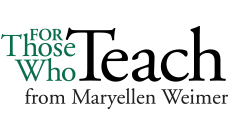“The Case for Cold-Calling. . .” I hadn’t finished reading the title before I started thinking, “I need to respond with the case against.” But I read on and changed my mind. The article proposed an approach to cold-calling that mitigated many of the objections I’d have put in a response. The 10–12 questions students will be called on to answer are put on the course website the day before the class convenes. The questions are basic, factual ones, with answers found in previous class notes or assigned readings. Correct answers earn a “nominal” amount of points.
Faculty author Sarah Kollat reports there’s a buzz when she arrives in class as students talk with each other about the questions. She randomly calls on individuals and they usually answer correctly. She has better attendance and higher exam scores, both she attributes to this use of the technique. 
Several points merit making here. With most techniques, it’s not the technique per se, but how it’s used, which is to say few techniques are inherently good or bad. Most can work well and most can function poorly. Sometimes our fixation with the technique obfuscates this larger truth.
More often than not, the difference is in the design details—sometimes in very small details. This approach to cold-calling is such a good illustration of that. One of the things that makes being called on so anxiety provoking for students is not knowing what you’ll be asked and not having time to prepare an answer. But having the questions beforehand enables students to come to class knowing the answers. Most students aren’t afraid to speak if they know the right answer.
The example also illustrates another feature of most techniques. They can accrue a range of outcomes, some of which may be unrelated to the technique itself. In this case, students essentially get a set of review questions that then structure how they prepare for class. Answers to those questions give students the working knowledge they need to more deeply master the new material that will be presented in class. It’s also an approach that gets students engaged with each other. Before class, there’s reason to talk; to explore the questions, exchange answers, and explain answers.
But the outcomes accrued are not always positive. Most techniques can also hinder or compromise efforts to learn. Calling on students puts them on the spot. If they give an incorrect or poor answer and it’s corrected in a less than constructive way, that student may be less willing to participate voluntarily in that class and in other classes.
Techniques need to be unpacked. They rest on premises and make assumptions about teaching, learning, and students. In the case of cold calling, it’s the belief that it’s okay to make students speak when they haven’t volunteered to do so. What if they have nothing to say? Declining to answer has implications—and most of them aren’t positive. It makes the student look unprepared and, if it’s regular occurrence, apathetic. Not knowing the answer (especially not knowing lots of answers) raises questions about ability. Then there’s the assumption that participating is a viable part of learning. What if the content can be learned by listening, reading, and private study? Why should students be required to talk about content that can be mastered without conversation? The point here is not the correctness of the assumptions related to cold-calling but the need to unpack techniques. They often look like straightforward approaches, but looks can be deceiving. There’s usually more to a technique than first meets the eye.
Finally, techniques don’t exist in splendid isolation. They are used in conjunction with other techniques, which means they influence and are influenced by each other. These connections and relationship should also be explored. All of these features of techniques impact the learning experiences of students. They deserve more than a quick reaction and superficial assessment.
Sarah H. Kollat (2018) The Case for Cold-Calling: Initiating Active Participation in the Classroom, College Teaching, DOI: 10.1080/87567555.2018.1463506 [1]